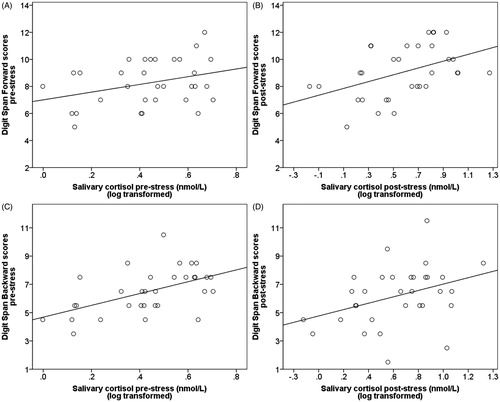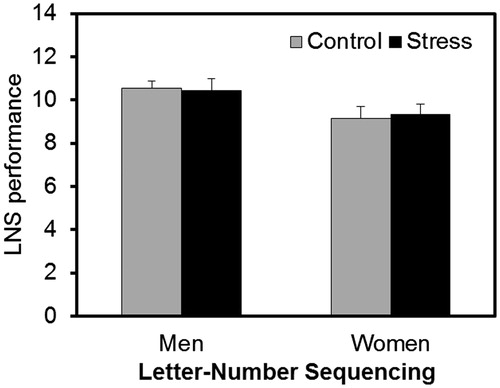Figures & data
Figure 1. Study 1: salivary cortisol concentrations for men and women. After a 15-min habituation phase (not represented in the figure), participants completed the STAI-pre (white rectangle with diagonal line). Afterwards, they performed the pre-stress Digit Span (dark gray rectangle with diagonal line). Next, they performed the TSST (light gray rectangle): (i) they were introduced to the task, (ii) they prepared the free speech and (iii) they performed the free speech and arithmetic tasks. Immediately after that, they completed the STAI-post (white rectangle), and after 10 min recovery, they performed the post-stress Digit Span (dark grey rectangle). The 0-min time point was fixed at the beginning of the free speech task.

Figure 2. Study 1: performance on Digit Span Forward (left) and Digit Span Backward (right) before (gray) and after (black) the stress task. *Women improved their performance on Digit Span Forward after the stress task (p = 0.004).

Figure 3. Study 1: scatter plots for the association between acute cortisol levels and Digit Span performance in women. (A) Relationship between acute cortisol levels and Digit Span Forward pre-stress (r = 0.349, p = 0.054). (B) Relationship between acute cortisol levels and Digit Span Forward post-stress (r = 0.443, p = 0.013). (C) Relationship between acute cortisol levels and Digit Span Backward pre-stress (r = 0.526, p = 0.002); this latter relationship remained significant after controlling for Digit Span Forward (r = 0.462, p = 0.010). (D) Relationship between acute cortisol levels and Digit Span Backward post-stress (r = 0.369, p = 0.041); this latter relationship did not remain significant after controlling for Digit Span Forward (r = 0.216, p = 0.252).

Figure 4. Study 2: salivary cortisol concentrations for men and women in the stress and control groups. After a habituation of 15 min (not represented in the figure), they completed the STAI-pre (white rectangle with diagonal line). Next, they were exposed to the TSST or control task (light grey rectangle): (i) they were introduced to the task, (ii) they prepared the free speech and (iii) they performed the free speech and arithmetic/counting tasks. Immediately after that, they completed the STAI-post (white rectangle) and after a recovery of 10 min, they performed the LNS test (dark gray rectangle). The 0-min time point was fixed at the beginning of the free speech. *Cortisol levels were higher in the stress group than in the control group in samples +5 min, +10 min and +25 min (all p < 0.011).


